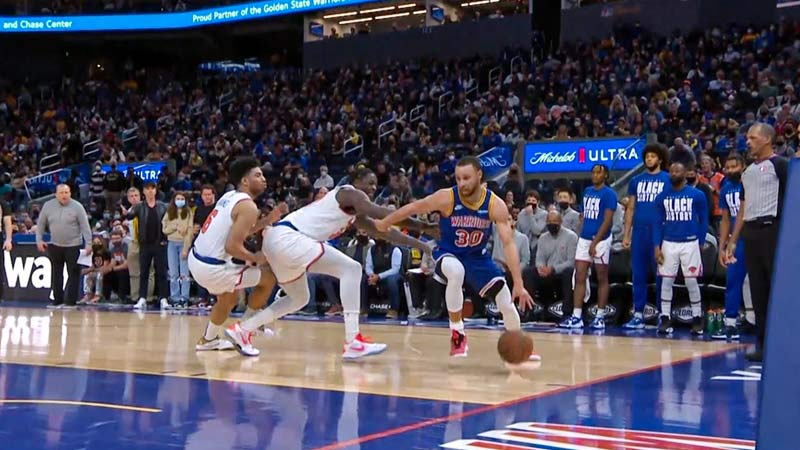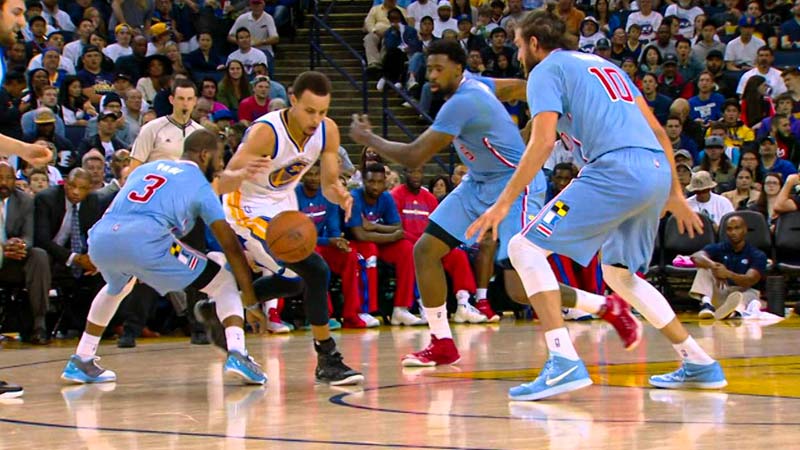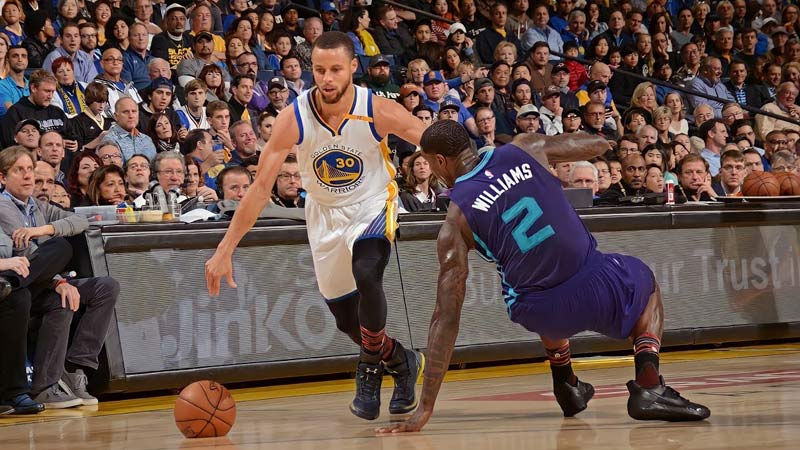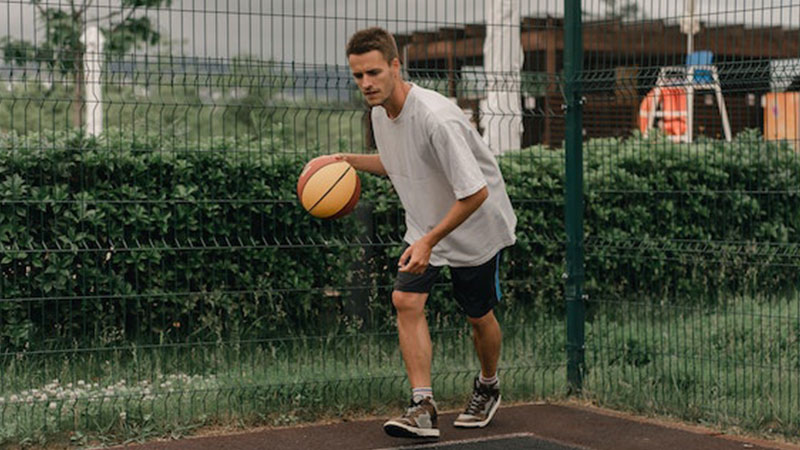Dribbling a basketball while running is a fundamental skill that is highly valued in the game of basketball. It requires coordination, agility, and a strong command over the ball.
The ability to dribble effectively while in motion showcases a player’s control and finesse and opens up numerous possibilities on the court.
Mastering this skill allows players to navigate through tight defenses, create scoring opportunities, and make quick decisions on the fly.
The question, “How to Dribble a Basketball While Running?” encapsulates many aspiring basketball players’ challenges. This article will explore the importance of dribbling while running and the various benefits of mastering this skill.
Whether you’re a beginner looking to improve or an experienced player aiming to enhance your game, understanding the intricacies of dribbling while running will undoubtedly elevate your basketball performance to new heights.
How To Dribble A Basketball While Running?
Dribbling a basketball while running requires a combination of technique, practice, and focus. This skill can significantly enhance a player’s offensive capabilities and provide a competitive advantage on the court. This section will explore the key elements and steps in effectively dribbling a basketball while in motion.
Proper Hand Placement
When dribbling while running, it is crucial to maintain proper hand placement on the ball. Use your fingertips rather than your palm to control and maintain a light grip.
Hand-Eye Coordination
Developing good hand-eye coordination is essential for successful dribbling while running. Keep your eyes up, scanning the court and anticipating the movements of defenders and teammates.
Body Positioning
Maintain a low and athletic stance while running with the ball. Bend your knees, keep your back straight, and stay balanced for better control and maneuverability.
Dribble Height And Force
Adjust the height and force of your dribble based on the situation. When running, a lower dribble closer to the ground can help you maintain speed and protect the ball from defenders.
Change Of Direction
Use quick direction changes and crossovers to evade defenders and create scoring opportunities. Practice different dribbling moves, such as between-the-legs and behind-the-back, to add versatility to your dribbling while running.
Speed And Timing
Develop the ability to synchronize your dribble with your running speed. Practice varying your pace and maintaining control of the ball at different rates.
By mastering the above-mentioned techniques and dedicating time to consistent practice, you can improve your ability to dribble a basketball while running. Remember, practice with purpose and focus on building muscle memory to enhance your skills on the court.
Preparing For Dribbling While Running

It is essential to properly prepare your body to ensure optimal performance and reduce the risk of injury while dribbling a basketball while running. This section will focus on two key aspects of preparation: warm-up exercises and strengthening the lower body.
Warm-Up Exercises
- Dynamic Stretches: Engage in dynamic stretches that target the muscles used during dribbling and running. Examples include leg swings, hip rotations, arm circles, and torso twists.
Busy times increase blood flow, improve range of motion, and loosen up the muscles, making them more responsive during the activity. - Hand-Eye Coordination Drills: Incorporate hand-eye coordination drills into your warm-up routine.
These drills can involve bouncing a basketball off a wall and catching it, performing quick hand exchanges with a partner, or practicing controlled dribbling while moving your head and eyes to different targets.
These exercises help sharpen your focus and enhance your ability to track the ball while running.
Strengthening The Lower Body
- Leg Exercises For Stability And Balance: Perform squats, lunges, and calf raises to strengthen your legs and improve stability. Strong leg muscles provide a solid foundation while running and dribbling, allowing for better control and balance.
- Plyometric Training For Explosiveness: Incorporate plyometric exercises like jump squats, box jumps, and lateral hops into your training regimen.
Plyometric training helps develop explosive power, which is crucial for quick changes in direction and acceleration while dribbling.
Techniques For Dribbling While Running

Dribbling a basketball while running requires a combination of specific techniques to maintain control and maximize effectiveness on the court. This section will explore fundamental techniques to help you improve your dribbling skills while in motion.
Maintain A Low And Athletic Stance
To enhance stability and maneuverability, bending your knees and staying on the balls of your feet is crucial. This position lowers your center of gravity, allowing for better control and quick direction changes.
Establish A Strong Dribbling Rhythm
Consistency in dribble height and tempo is vital for maintaining control and keeping defenders off balance. Practice holding a steady rhythm to enhance your ability to dribble effectively while running.
Use Your Non-Dribbling Arm For Balance
Your non-dribbling arm plays a significant role in maintaining balance and stability while running with the ball. Position it slightly in front of you, keeping it bent and ready to react to any changes in direction.
Employ Effective Body Positioning:
When dribbling while running, protecting the ball from defenders and creating space for yourself is essential. Use your body to shield the ball, maintaining a solid position that makes it difficult for defenders to steal it.
Utilize Effective Change-Of-Direction Moves
Mastering change-of-direction moves can give you an edge while dribbling on the move. The crossover, behind-the-back dribble, and between-the-legs dribble are three common techniques that allow you to change direction quickly and leave defenders behind.
Developing Speed And Agility While Dribbling

Developing speed and agility while dribbling is crucial for basketball players, allowing them to navigate the court quickly and evade defenders effectively. In this section, we will explore specific drills and exercises that can help improve both speed and agility while dribbling.
Incorporating Sprinting Drills:
- Interval Training For Acceleration: Interval training involves alternating between high-intensity sprints and brief rest periods. This drill helps improve acceleration, enabling players to burst forward with speed while dribbling.
- Lateral Movement Exercises: Lateral movements are essential for quick changes of direction while dribbling. Incorporate drills focusing on lateral speed, such as side shuffles, defensive slides, or lateral cone hops.
Enhancing Agility Through Cone Drills:
- Figure-Eight Drill: Set up cones in a figure-eight pattern and dribble through them, focusing on sharp turns and quick direction changes. This drill improves agility, coordination, and control while dribbling at different speeds.
- Zigzag Drill: Place cones in a zigzag formation and practice dribbling through them while maintaining control and speed. This drill enhances agility, as players must quickly change directions while dribbling.
Game Situations And Strategies
In the game of basketball, the ability to dribble while running opens up a plethora of game situations and strategic advantages. Understanding and navigating these scenarios can significantly enhance a player’s overall performance.
This section will delve into specific game situations where dribbling while running plays a crucial role and explore the strategies associated with them.
Fast Break Situations
- Dribbling In Transition: During fast breaks, dribbling while running allows players to maintain control of the ball while advancing quickly toward the basket.
It enables them to push the tempo, keeping the defense on their heels and potentially leading to scoring opportunities. - Making Quick Decisions: Dribbling while running in fast-break situations requires split-second decision-making.
Players must assess the defensive positioning, identify open teammates, and choose between driving to the basket or making a pass for a higher percentage shot.
Attacking The Basket
- Using Dribbling To Penetrate Defenses: Dribbling while running becomes a powerful weapon when attacking the basket. Skilled ball handlers can use their dribble to navigate through defenses, creating openings to drive into the paint and draw fouls or kick out to open teammates.
- Finishing At The Rim: Dribbling while running allows players to maintain momentum and control as they approach the rim. They can execute finishing moves, such as layups, floaters, or euro steps, to score effectively in traffic.
Creating Scoring Opportunities For Teammates
- Dribble Penetration And Kick Outs: By dribbling while running, players can attract defensive attention and collapse the defense. This creates opportunities to kick the ball out to open teammates on the perimeter, who can take uncontested shots.
- Drawing Defenders And Making Passes: Skilled dribblers can manipulate defenses by drawing multiple defenders toward them. By doing so, they create passing lanes and can make accurate passes to open teammates for easy scoring chances.
Incorporating these strategies into your game and mastering dribbling while running will elevate your overall effectiveness on the court.
It allows you to score more efficiently and empowers you to create opportunities for your teammates, making you a valuable asset to any team’s offensive arsenal.
Common Mistakes To Avoid

Avoiding common mistakes is crucial for mastering the skill of dribbling a basketball while running. These mistakes can hinder your progress and limit your effectiveness on the court. This section will highlight some of the most common errors to watch out for and provide insights on rectifying them.
Dribbling Too High
Dribbling the ball too high while running makes it vulnerable to steals from opponents. Maintain control by keeping the dribble low and close to the ground. This ensures better ball security and reduces the risk of turnovers.
Over-Reliance On The One Hand
Relying solely on the one hand for dribbling limits your options and makes you predictable to defenders. Develop ambidexterity by practicing dribbling drills with both hands. This enhances your ability to maneuver and protect the ball in different situations.
Lack Of Ball Control And Coordination
Insufficient ball control and coordination can lead to turnovers and missed opportunities. Work on strengthening your hand-eye coordination through dribbling exercises focusing on quick reactions, agility, and precise ball handling.
Poor Body Positioning And Balance:
Maintaining proper body positioning and balance is essential for effective dribbling while running. A poor stance can make it difficult to change directions quickly and protect the ball. Focus on staying low, keeping your core engaged, and staying balanced while in motion.
Practice Drills For Dribbling While Running
Developing the ability to dribble a basketball while running requires consistent practice and drills that simulate game-like scenarios. This section will explore effective practice drills and exercises that can help improve your dribbling skills while in motion.
Full-Court Dribbling Drills:
- Two-Ball Dribbling: This drill involves dribbling two basketballs simultaneously while running the length of the court. It helps improve ball control, coordination, and ambidexterity. Focus on maintaining a consistent rhythm and alternating dribbles between the two balls.
- Dribbling Through Obstacles: Set up cones or obstacles along the court and practice dribbling through them at full speed. This drill enhances your ability to maneuver around defenders and improves your ball-handling skills in challenging situations.
Game-Like Scenarios:
- 1-On-1 Dribbling Challenges: Engage in one-on-one matchups where the objective is to dribble past your defender and score.
This drill improves your dribbling under pressure and enhances your decision-making skills as you read and react to the defender’s movements. - Incorporating Dribbling Into Team Drills: Integrate dribbling exercises into team drills like fast breaks or offensive sets.
This allows you to work on dribbling while running in a realistic game context, improving your ability to make quick decisions and execute precise dribbling moves in a dynamic setting.
Frequently Asked Questions
How can I improve my dribbling speed while running?
To improve your dribbling speed, focus on maintaining a low center of gravity, using quick and efficient dribble moves, and practicing dribbling drills that require speed and agility.
Can dribbling while running help me become a better passer?
Yes, dribbling while running can enhance your passing skills. It enables you to create passing lanes, make accurate passes on the move, and react quickly to defensive situations.
How can I improve my weak hand dribbling while running?
Focus on practicing dribbling drills that specifically target your weak hand. Start with simple dribbling exercises and gradually progress to more complex routines that challenge your soft hand’s control and coordination.
Are there any specific dribbling moves I should learn for dribbling while running?
Learning various dribbling moves, such as crossovers, between-the-legs, and behind-the-back dribbles, can add versatility to your dribbling while running. Practice these moves to develop a well-rounded dribbling skill set.
Conclusion
Mastering dribbling a basketball while running is crucial for any basketball player. It improves your ability to navigate the court and enhances your overall ball handling, decision-making, and offensive capabilities.
You can significantly improve your dribbling while running by focusing on proper hand placement, hand-eye coordination, and body positioning, and practicing specific drills.
Embrace the challenge, invest time in consistent practice, and watch your skills on the court soar to new heights. Keep dribbling, keep running, and keep evolving as a player.







